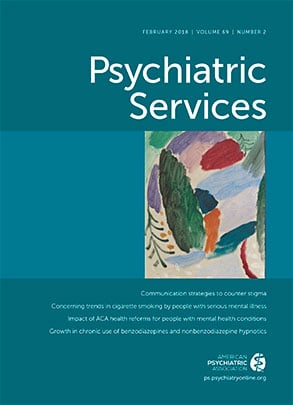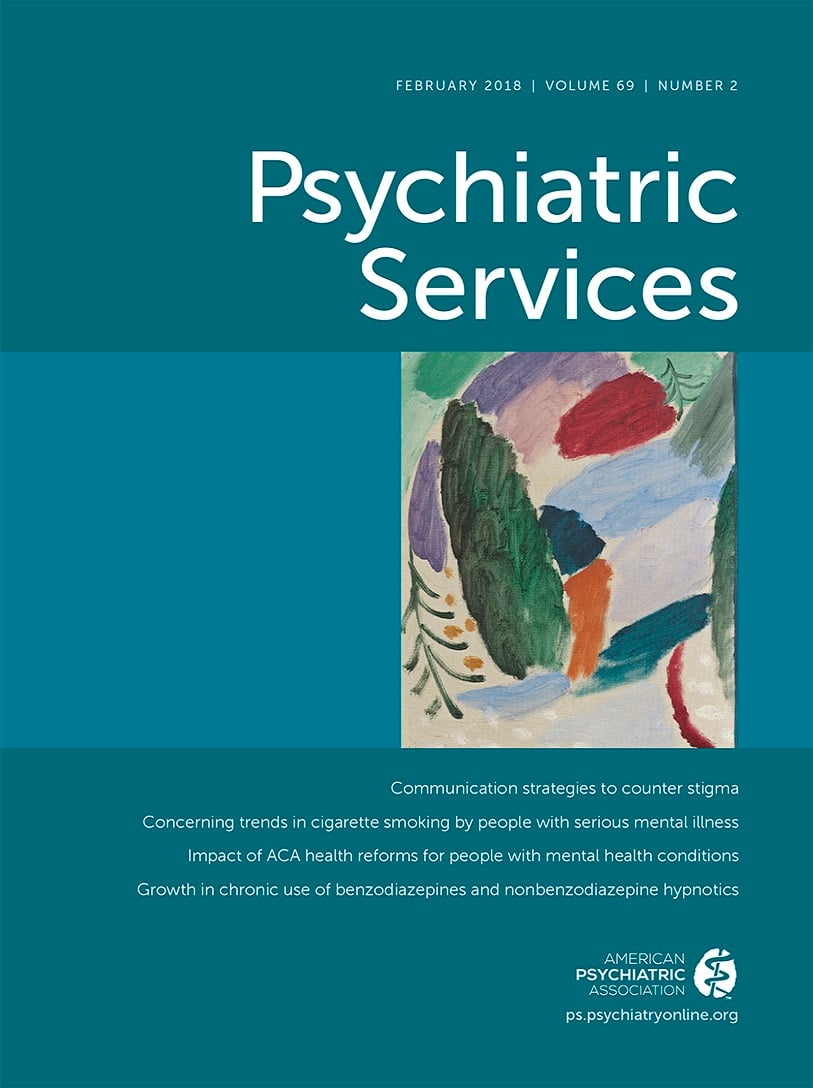Studies show increased prescribing of medications commonly used for treatment of anxiety and sleep disorders, specifically benzodiazepines (BZDs) and non-BZD hypnotics (NBHs), since the early 1990s (
1,
2), despite concerns about adverse health outcomes associated with their use (
3,
4). There is evidence that chronic use of these medications, particularly BZDs, is associated with falls and hip fractures (
3,
4) and even accidental overdose when combined with opioids, alcohol, or both (
5). Concerns that long-term use may be associated with adverse outcomes (
6) have prompted guidelines recommending use of these medications on a short-term basis (
6,
7). In recently published treatment guidelines for chronic insomnia, the American College of Physicians recommended that these medications be used only on a short-term basis and only if behavioral treatments alone are ineffective (
8). Similarly, the National Institute for Health and Care Excellence recommends against long-term use of BZDs for treatment of generalized anxiety disorder (
9).
We recently reported that increases in continuing prescriptions (i.e., refills), rather than new prescriptions for these medications, are driving the growing trends in their prescribing, suggesting an increase in the long-term use of these medications (
10). However, continued prescribing may not directly translate into long-term use by patients. For example, a patient may have received a prescription from a physician but not filled it at the pharmacy. Alternatively, a patient may have received a prescription for a medication to be used on an “as needed” basis and used the prescription rarely if at all. To our knowledge, no research has examined trends in long-term use of BZDs and NBHs. Olfson et al. (
11) examined data on dispensed prescriptions and estimated that long-term use (defined as more than 180 days of refills) of BZDs ranged from .4% among those ages 18 to 35 to 2.7% for those ages 65 to 80. However, that report was limited to one year (2008) and did not assess long-term NBH use.
Furthermore, little is known about whether indications for use of these medications are associated with duration of use. Whereas NBHs are prescribed primarily for insomnia, BZDs have broad indications, including anxiety, epilepsy, and alcohol withdrawal, in addition to insomnia; the underlying chronicity of these specific conditions may explain long-term use patterns. For example, it is possible that BZDs tend to be used on a long-term basis when used for anxiety, whereas they are used on a short-term basis for insomnia.
In this report, we examined national trends in long-term use of BZDs and NBHs from 1999 through 2014. This work in part extended a study by Bertisch et al. (
12), which used National Health and Nutrition Examination Survey (NHANES) data; the authors found an increase in the prevalence of use of insomnia medications from 1999 to 2010. On the basis of our own research (
1) and that of Bertisch et al. (
12), we hypothesized that the use of BZDs and NBHs increased between 1999 and 2014 and that this was driven by long-term use of these agents.
Methods
Data came from eight waves of the NHANES between 1999 and 2014. NHANES is a nationally representative cross-sectional survey conducted biennially (data obtained from
http://www.cdc.gov/nchs/nhanes/index.htm). NHANES conducts in-person interviews of noninstitutionalized U.S. respondents who are sampled using multistaged stratified probability sampling methods. Response rates ranged from 71% to 84% across waves.
NHANES interviewers recorded medications used during the preceding month on the basis of inspection of prescription bottles provided by participants, and participants reported duration of use for each medication. BZDs included alprazolam, chlordiazepoxide, clonazepam, clorazepate, diazepam, estazolam, flurazepam, lorazepam, oxazepam, temazepam, and triazolam. NBHs included zolpidem, zaleplon, and eszopiclone.
On the basis of a previous study (
13), we categorized length of use into short term (less than six months), medium term (six to 24 months), and long term (more than 24 months). If participants used more than one medication from a class, use duration was based on the longest-used drug.
Analyses were conducted in three stages. First, we compared participant characteristics across the use durations for BZDs and NBHs and tested for differences through chi-square tests. Next, we assessed trends between 1999 and 2014 in the prevalence of short-, medium- and long-term use of BZDs and NBHs by using logistic regression models with dummy-coded variables of short-, medium- and long-term BZD and NBH use as the outcome and time as the predictor. Time was transformed by subtracting one and dividing by seven, yielding a variable ranging from zero (1999–2000 wave) to one (2013–2014 wave). Thus the odds ratios from these models represent change in use over the entire study period. We further compared trends among short-, medium- and long-term use, using seemingly unrelated regression analyses (the “suest” command in Stata).
Because changing trends in use of BZDs and NBHs may be in part driven by shifts in age and racial structure of the U.S. population (
14), we repeated the analyses after controlling for age and race-ethnicity.
Finally, we explored the self-reported reason for BZD and NBH use. Beginning in 2013–2014, participants reported up to three reasons for medication use. We examined the distribution of use durations (short-, medium-, and long-term use) for each self-reported reason.
This analysis was exempt from review by an institutional review board. Analyses were conducted in Stata SE, version 13 (StataCorp), and accounted for the NHANES weights and complex sampling design.
Results
Across all years, .5% of participants were short-term users of BZDs, .9% medium-term users, and 1.4% long-term users. Those with increasing BZD use durations were generally older, more likely to be male, more likely to have a high school diploma, and more likely to be non-Hispanic white than were those with no BZD use or with shorter duration of BZD use (p<.001 for all comparisons). [A table summarizing characteristics of users and nonusers of BZDs is available as an online supplement to this report.] Additionally, .2% were short-term users of NBHs, .4%, medium-term users; and .4%, long-term users. The sociodemographic correlates of long-term NBH use were similar to the correlates of long-term BZD use (p≤.014 for all comparisons) [see online supplement].
BZD and NBH use increased significantly over the study period (from 2.0% of respondents in 1999–2000 to 4.2% in 2013–2014 for BZDs [p<.001] and from .4% in 1999–2000 to 1.6% in 2013–2014 for NBHs [p<.001]). Trends were driven by increases in use of more than six months (
Figure 1). From 1999 to 2014, odds of BZD use increased for medium-term use (odds ratio [OR]=1.45, 95% confidence interval [CI]=1.02–2.07, p=.039) and for long-term use (OR=2.17, CI=1.56–3.01, p<.001), but there were no significant changes for short-term use. In seemingly unrelated regression analyses, there were marginally significant differences across BZD duration use regressions (F=2.94, df=2 and 122, p=.057). Odds of NBH use increased for medium-term use (OR=2.18, CI=1.34–3.55, p=.002) and for long-term use (OR=8.32, CI=4.93–14.04, p<.001), with no significant change in short-term use. Across regressions, there were significant differences across NBH models (F=8.22, df=2 and 122, p<.001).
Results were similar after adjustment for age and race-ethnicity. After adjustment, odds of BZD use increased for long-term use (adjusted odds ratio [AOR]=1.97, CI=1.42–2.74, p<.001) and remained marginally significant for medium-term use (AOR=1.41, CI=.98–2.02, p=.066). Odds of NBH use increased for medium-term use (AOR=2.22, CI=1.33–3.71, p=.003) and for long-term use (AOR=7.78, CI=4.55–13.30, p<.001). For these adjusted analyses, in seemingly unrelated regression analyses, there was still a statistically significant difference across NBH models (F=7.29, df=2 and 122, p=.001), whereas differences across BZD models were insignificant.
In 2013–2014, virtually all of the 96 listed NBHs (97.9%) were used for sleep problems, and of these 94 NBHs, 85.1% were used on a medium- or long-term basis. Among the 290 BZDs listed, 60.3% were used for anxiety problems, 29.3% for sleep problems, 11.4% for mood problems, 9% other reasons; .7% had missing reasons. About 83% of BZDs used for anxiety problems were for medium- or long-term use, as were most BZDs used for sleep problems (84.7%), mood problems (81.8%), and other problems (69.2%).
Discussion
We found a growing trend in use of both BZDs and NBHs between 1999 and 2014, mirroring trends seen in prescription of these medications (
1,
2). We further found that growth in use was almost entirely attributable to increases in medium- and long-term use (more than six months), suggesting that this pattern of use may be driving the increasing overall trend in the use of these medications. In exploratory analyses, long-term use of BZDs and NBHs was common regardless of indication.
Our findings of increased long-term use of BZD and NBH medications are not in accordance with recommendations in clinical prescribing guidelines, which generally discourage their long-term use (
7–
9). Future research needs to identify instances in which long-term use of sedating agents may be clinically indicated, differentiating these cases from those in which long-term use may be associated with greater likelihood of adverse outcomes. Furthermore, research may seek to identify means of monitoring risk of future adverse outcomes in long-term users, especially as they age. Such efforts may be feasible with the wider adoption of prescription drug monitoring programs. The observed trends could not be attributed to changes in the age or racial/ethnic structure of the U.S. population because they persisted even after controlling for age and race-ethnicity.
Although trends in long-term prescription and use of BZDs and NBHs are clear, the reasons for these trends are not. Whereas direct-to-consumer marketing may have driven NBH use in the early years of our study, it was most likely not responsible for increases in use of the older BZDs and recent increases in use of NBHs because their generic formulations were introduced in later years. Results from our previous study in prescribing suggested growth of prescribing in primary care practices (
1). Thus changes in composition of the providers prescribing these medications and differences in practice styles may be, at least partly, responsible for the trend. Changes in public attitudes toward these medications, and psychiatric medications in general, may be another explanation. Regardless, research needs to assess patient and provider views of BZDs and NBHs and assess for these changing attitudes over time.
There is ample evidence supporting efficacy of behavioral treatments for insomnia and anxiety disorders (
15). Although cognitive behavioral therapy for anxiety is widely available, the use of behavioral treatments for insomnia is much less common (
15). There are efforts to implement cognitive behavioral therapy for insomnia in primary care settings as well as through the Internet and smartphone apps. Our findings highlight the need for wider dissemination of these interventions in various settings.
Conclusions
This study indicated that the observed increases in BZD and NBH use in recent years may be attributable to growth in long-term use. Limitations included the study’s cross-sectional design and reliance on self-report data for medication use duration and reasons for use. Monitoring of long-term BZD and NBH use, particularly in vulnerable patients (for example, older adults), may be important for understanding the reasons for changing patterns of use of these medications and prevention of potential adverse health outcomes associated with their use. Additionally, promoting the availability of behavioral sleep treatments may help reduce the need for pharmacological sleep interventions, because sleep problems remain a major reason for their long-term use. Findings highlight the pressing need for better delineation of appropriate medium- and long-term use of these medications.


